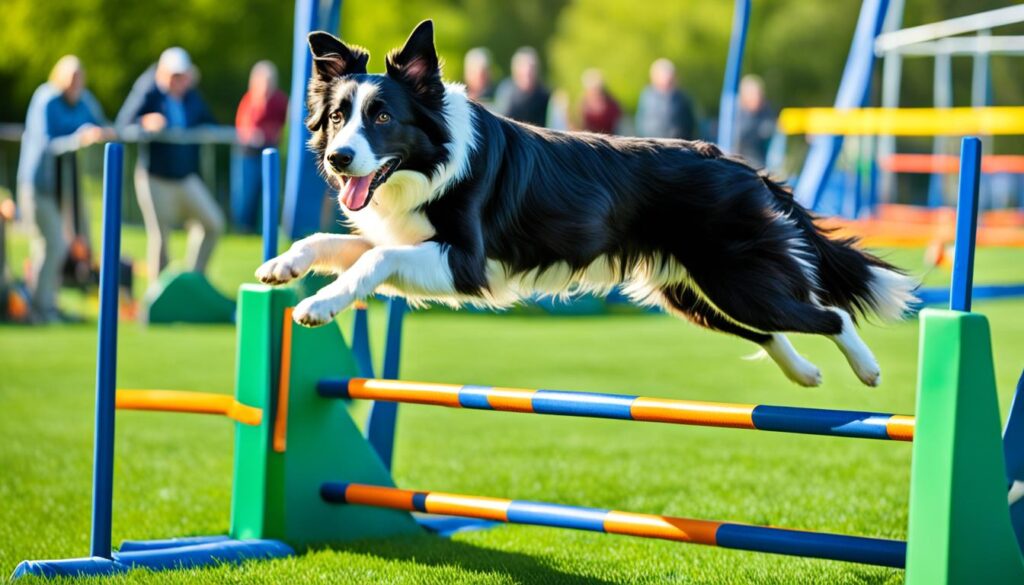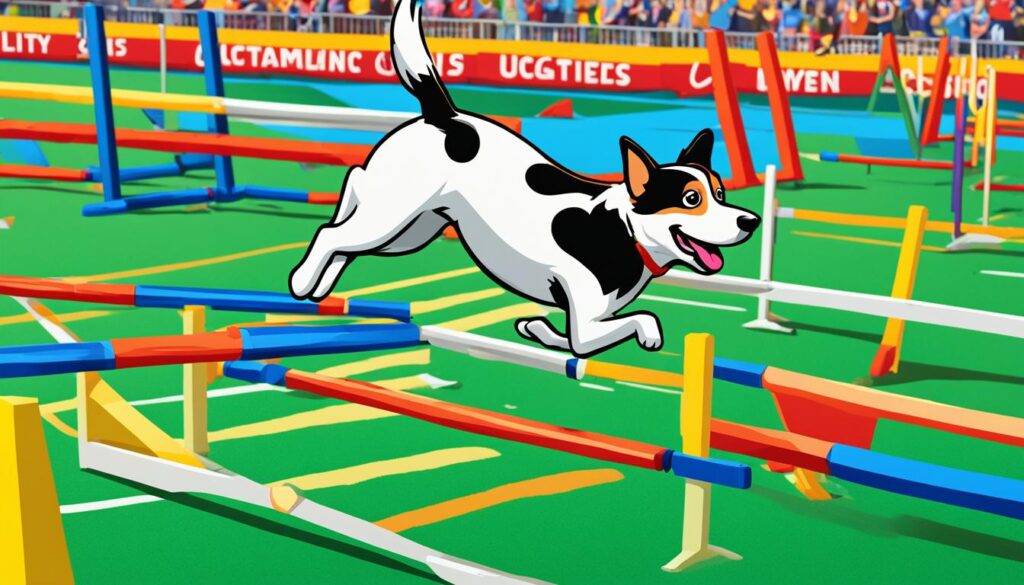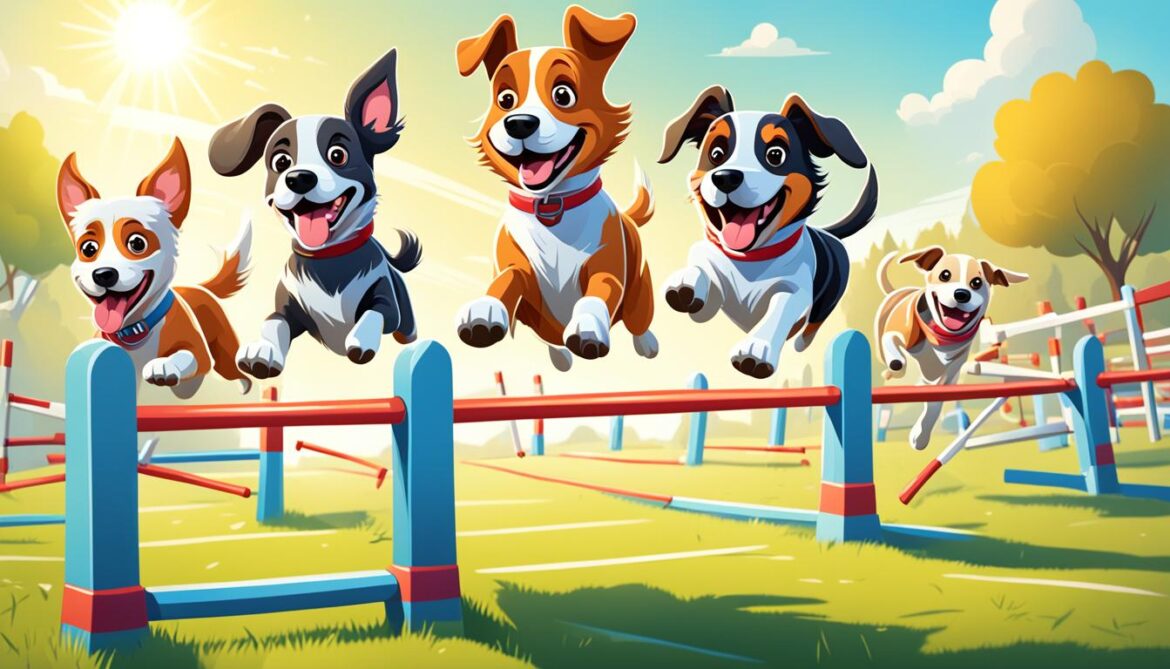Imagine the sheer joy and excitement that fills your dog’s eyes as they effortlessly navigate through an obstacle course, their tail wagging with pure delight. You can almost feel their energy and enthusiasm radiating through every fiber of their being. This is the transformative power of agility training for dogs.
Agility training is not only a physically stimulating activity for your furry friend but also a mentally engaging experience that unlocks their true potential. It challenges them to overcome obstacles, build confidence, and tap into their innate agility and intelligence.
Whether you have a playful pup, an energetic young dog, or even a seasoned companion, agility training offers a multitude of benefits that go beyond just exercise.
Are you ready to embark on an exciting journey of discovery and growth with your canine companion? Let’s explore the world of agility training together and uncover the endless possibilities it holds.
Key Takeaways:
- Agility training for dogs is a transformative experience that boosts their confidence and energy levels.
- It provides both physical exercise and mental stimulation for your furry friend.
- Agility training helps dogs overcome obstacles and tap into their natural agility and intelligence.
- It is suitable for dogs of all ages and breeds, offering a fun and rewarding activity for both you and your canine companion.
- By engaging in agility training, you can strengthen the bond and communication between you and your dog.
Get Started with Dog Agility Classes
Ready to dive into agility training with your furry companion? Dog agility classes offer a structured and supportive environment to unleash your dog’s potential. Whether you’re a beginner or have previous experience in dog training, agility classes cater to dogs of all ages and skill levels.
Agility training brings numerous benefits to your dog’s physical and mental well-being. It helps improve their coordination, strength, and endurance while providing mental stimulation and building their confidence.
Before enrolling in dog agility classes, it’s essential to understand the equipment used in training. Here are some common agility training equipment items:
| Agility Equipment | Description |
|---|---|
| Jumping obstacles | These include hurdles, tunnels, and similar structures that train dogs to clear obstacles with precision. |
| Weave poles | A series of vertical poles that dogs must navigate in a zigzag pattern, enhancing their agility and focus. |
| A-frame | A steep incline followed by a descent, teaching dogs to ascend and descend safely. |
| See-saw | A balancing equipment that challenges dogs to maintain stability while crossing. |
Quality agility training equipment is crucial for your dog’s safety and success. Make sure to invest in durable and well-constructed equipment that meets safety standards.
When selecting a dog agility trainer, it’s important to find someone experienced and knowledgeable. Look for trainers who specialize in agility training and have a good reputation among the dog training community. Seek recommendations from fellow dog owners or local dog training facilities.
To help you find the best dog agility trainers in your area, consider the following tips:
- Research local training facilities and read online reviews from their previous clients.
- Visit the facilities and observe a class to assess the trainer’s coaching style, class atmosphere, and overall professionalism.
- Ask for certifications or training credentials to ensure the trainer has the necessary expertise.
By joining dog agility classes with the right equipment and trainers, you’ll create a solid foundation for your dog’s agility journey. In the next section, we’ll explore specialized canine agility courses that can take your dog’s agility skills to the next level.
Take Your Dog’s Agility Skills to the Next Level with Canine Agility Courses
Enrolling your dog in specialized canine agility courses can take their agility skills to new heights. These courses provide a comprehensive and advanced approach to agility training, focusing on enhancing your dog’s abilities through a variety of exercises and challenges.
By participating in canine agility courses, your dog can benefit from:
- Structured Training: Canine agility courses offer a structured environment where your dog can learn and practice agility skills under the guidance of experienced trainers.
- Advanced Exercises: These courses introduce a variety of challenging exercises that go beyond basic agility training, allowing your dog to develop improved speed, coordination, and problem-solving abilities.
- Targeted Coaching: During canine agility courses, trainers can provide targeted coaching tailored to your dog’s specific needs, helping them overcome any hurdles and reach their full potential.
- Building Confidence: The combination of structured training and advanced exercises in these courses helps boost your dog’s self-confidence, making them more resilient and eager to take on new challenges.
If you’re looking for agility training exercises to incorporate into your routine, try the following:
- Tunnel Run: Set up a tunnel obstacle in your backyard or a designated area. Teach your dog to run through the tunnel with enthusiasm and speed. Start with a straight tunnel and gradually introduce curves for added difficulty.
- Weave Poles: Arrange a series of weave poles in a straight line. Guide your dog through the poles, encouraging them to weave in and out. Increase the difficulty by decreasing the distance between the poles.
- A-Frame Climbs: Construct or purchase an A-frame obstacle for your dog to climb. Train them to ascend and descend the A-frame with confidence and agility.
These exercises can help enhance your dog’s agility skills and prepare them for more advanced challenges in canine agility courses.

Discovering the world of canine agility courses can unlock your dog’s full potential and bring excitement to their training journey. Embrace these specialized courses, and witness the remarkable progress your dog can achieve in agility skills.
Prepare for Dog Agility Competitions
If you and your dog have mastered the art of agility training and are looking for a thrilling challenge, it’s time to consider dog agility competitions. These events allow you to showcase your dog’s agility skills and compete against other talented teams. However, before diving into the world of competition, it’s essential to be well-prepared.
Training Tips for Dog Agility Competitions
Preparing for dog agility competitions requires a dedicated training regimen that focuses on refining your dog’s agility skills and building their confidence in various environments. Here are some agility training tips to help you and your furry companion prepare:
- Practice different course layouts: Dog agility competitions feature a wide range of obstacle courses. Design courses that simulate competition settings, exposing your dog to various obstacles and challenges.
- Work on speed and accuracy: In competitions, speed and accuracy are vital. Incorporate timed exercises to improve your dog’s agility and ensure they can complete courses efficiently without compromising precision.
- Focus on consistency: Consistency is key in agility competitions. Train regularly at the same time and location to replicate the competitive atmosphere and help your dog become accustomed to distractions.
- Master off-leash control: Competitions require dogs to navigate courses off-leash. Practice off-leash control commands, such as recalls, stays, and directional cues, to ensure your dog can confidently complete courses without relying on a leash.
- Expose your dog to new environments: Introduce your dog to different training locations, surfaces, and settings. This exposure will help them adapt quickly to competition venues and remain focused amidst unfamiliar surroundings.
By incorporating these training tips into your agility routine, you and your dog will be well-prepared to tackle the challenges of dog agility competitions.
“Training for agility competitions requires dedication, consistency, and a strong bond between you and your dog. Remember to have fun and enjoy the process along the way!”
Understanding Competition Rules and Regulations
Before participating in dog agility competitions, it’s crucial to familiarize yourself with the specific rules and regulations of the organizations hosting the events. Each competition may have slightly different requirements, including course layouts, obstacle specifications, and scoring systems. By understanding these rules, you can ensure that you and your dog are fully prepared and can compete fairly.
Research and join reputable agility organizations, such as the American Kennel Club (AKC) or the United States Dog Agility Association (USDAA), to gain access to competition guidelines and resources. These organizations provide comprehensive information and support for competitors, including rule books, event calendars, and additional training resources.
Remember that every agility competition is an opportunity for growth and improvement. Embrace the adrenaline, celebrate your achievements, and learn from each experience to keep progressing on your agility journey.

Preparing for dog agility competitions requires dedication, practice, and a deep understanding of the competition environment. With the right training tips, knowledge of competition rules, and a positive mindset, you and your dog can confidently step onto the agility course and showcase your skills. Take the plunge into the exhilarating world of dog agility competitions and embark on unforgettable adventures with your four-legged teammate.
Enhance Your Dog’s Agility Journey with Useful Tips
Agility training is an exciting and rewarding way to bond with your dog while improving their physical and mental abilities. To help you enhance your dog’s progress on their agility journey, we’ve compiled some valuable training tips. By following these tips, you and your four-legged companion can excel together and achieve new heights in agility training.
1. Build a Solid Foundation
To set your dog up for success in agility training, it’s essential to build a solid foundation of basic obedience skills. Teach your dog commands like sit, stay, and come reliably before introducing them to agility equipment. A strong foundation in obedience will help your dog understand cues during agility training and perform tasks with precision.
2. Start with Simple Obstacles
When introducing your dog to agility equipment, start with simple obstacles like tunnels or low jumps. Allow them to explore and familiarize themselves with each element at their own pace. This gradual approach ensures that your dog feels comfortable and confident, preventing any fear or anxiety associated with the equipment.
3. Use Positive Reinforcement
Positive reinforcement, such as treats, praise, or play, is a powerful tool for motivating and reinforcing desired behaviors in your dog. Reward your dog abundantly when they successfully complete an agility task or demonstrate progress. This positive association will encourage them to continue their agility journey with enthusiasm.
4. Break it Down into Small Steps
Agility courses can be complex, with multiple obstacles and sequences. To prevent overwhelm and foster understanding, break down the course into small steps. Teach your dog each obstacle individually, gradually combining them to create longer sequences. This approach allows your dog to master each element before moving on to more challenging combinations.
5. Focus on Speed and Accuracy
In agility training, both speed and accuracy are crucial. Encourage your dog to complete the course quickly while maintaining precise movements. Use timed exercises and set goals to improve their speed gradually. Remember to reward their accuracy and precision along the way, helping them become faster without sacrificing accuracy.
6. Practice Consistently
Consistency is key when it comes to agility training. Set aside regular training sessions, ideally several times a week, to practice agility exercises with your dog. This consistent practice will reinforce skills, improve muscle memory, and enhance the bond between you and your furry friend.
“Agility training is a journey of teamwork and communication between you and your dog. With patience, dedication, and these useful tips, you can unlock your dog’s full potential and enjoy the incredible rewards of agility training.” – Jane Smith, Certified Dog Trainer
Remember, each dog is unique, and progress may vary. Celebrate every milestone and adjust the training approach to suit your dog’s individual needs. As you continue on your agility journey, always prioritize safety and ensure that you and your dog have fun along the way.
Conclusion
In conclusion, agility training for dogs is a fantastic way to boost your furry friend’s confidence, energy, and overall well-being. Whether you choose dog agility classes or invest in specialized canine agility courses, with the right equipment, trainers, and tips, you and your dog can unlock their full potential in the exciting world of agility training. Start your agility journey today and watch as your dog’s skills and bond with you continue to grow.
